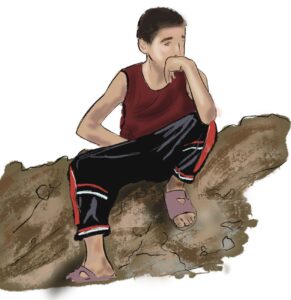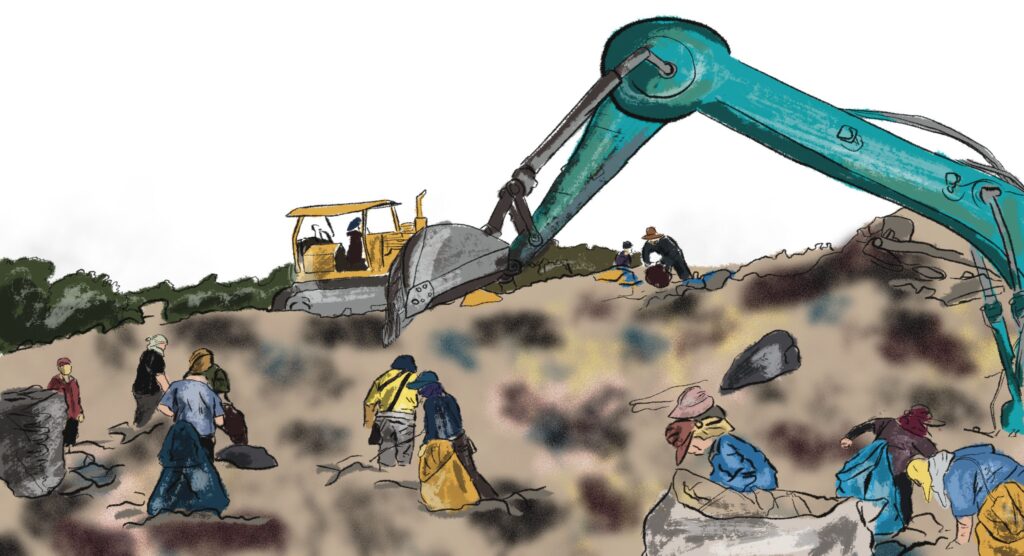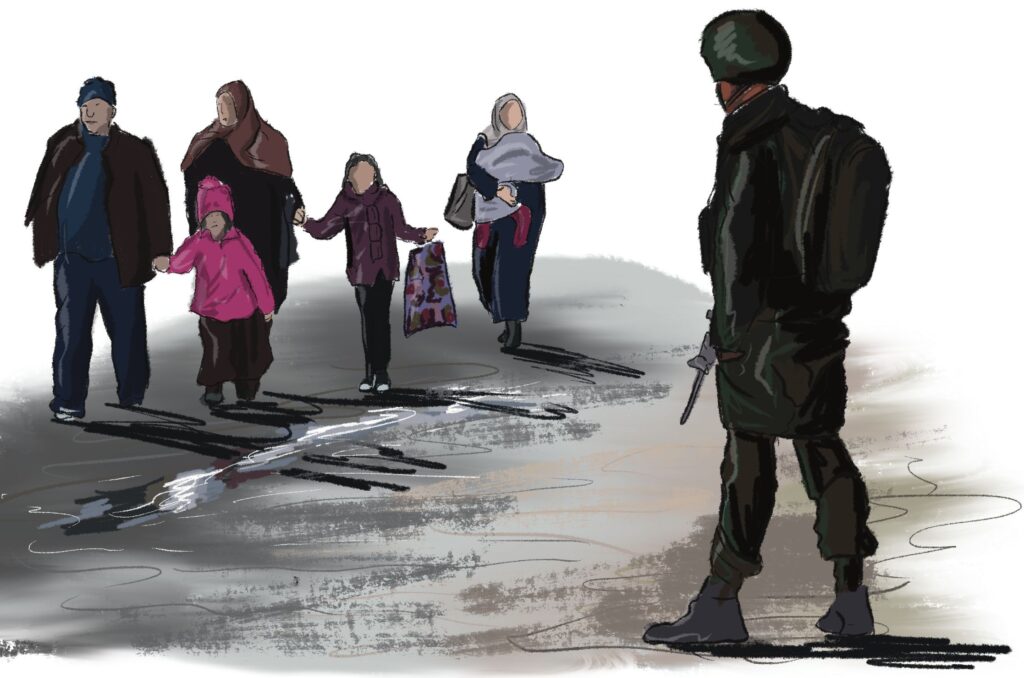Days of Palestine
By Sumayya FS
Gaza
A population of nearly 2 million, of which 1.17 million are minors, 262,000 are under the age of 5, and 1.17 million live in poverty. An unemployment rate of 62%. Gaza is a city. Gaza is a home. Gaza is a resistance. Gaza is a humanitarian crisis.
The public water-supply system that 97% of the population is connected to is unfit for drinking(1). Gaza requires around 600 megawatts of electricity for a twenty-four-hour electricity supply; Gaza only receives 180 megawatts, i.e. four to eight hours of electricity per day. Without electricity, water can’t be piped either.
Operation Protective Edge in 2014. One month long. 2,145 Palestinian casualties. Great March of Return in 2018 –
2019. 183 Palestinian casualties(2). 9,204 shot, hit by shrapnel or tear-gas canisters, including 6,106 injured by snipers leading to “life-changing wounds” in many(3). Approximately 22,500 children were in the need of psychosocial support in 2020(4).
Gaza’s neighbours, Israel and Egypt have largely cut off the movement of goods and people in and out of Gaza. While Israel controls Gaza’s air, land and sea borders, Egypt’s Rafah crossing has been shut-down by the Egyptian government. Today, at least 54% of Gazans are food insecure and over 75% are dependent on aid(5).
Yara Younes, Life in Gaza: The world’s largest open air prison | The Palestine Project
Day 1 – Youth Under Occupation
Abdalrahim is a Palestinian who was raised in the UAE. In 2011, he returned to Gaza where he attended university. Since then, saying that his life was turned upside-down might be an understatement.
Gaza was a world apart compared to his relatively easy upbringing in the UAE. Perhaps the first thing to hit him was the electricity crisis. Gaza gets four to eight hours of electricity in a day. Moreover, if Israel is carrying out a military operation in Gaza, electricity remains gone without warning for two to three days, sometimes for even over a week.
With the electricity so limited, his mother appears to be in a constant race against time – she needs to use every last minute of it to get through as many household chores as possible. Refrigerators are a luxury they can no longer afford, and food must be bought fresh.
The border blockade and the harsh reality of unemployment in Gaza is a constant pressure in the back of Abdalrahim’s mind, just like every other young person in Gaza. The suffocating siege is both physical and mental. The youth cannot plan out their futures, they can only live a day at a time. In Gaza, when you make it through one hardship, your next question isn’t ‘what next?’. Rather, it’s ‘how long till the next attack / problem / raid / arrest?’
Covid times mean unexpected plan changes sudden closures, constant uncertainty, restriction of movement and mounting frustrations. This is perhaps the closest the rest of the world can get to imagining daily life in Gaza. Isolated and terrified, and expecting to die at any moment – this is life for many in Gaza.
The words ‘Gaza’ and ‘hope’ seem like oxymorons.
Abdalrahim’s friend Youssef AlKrunz was once a superb footballer. In 2018, he participated in the Great Return March as a media person. He was gratuitously shot twice in his legs by Israeli snipers. Fortunately, he was hospitalized immediately and received treatment. The shots, however, resulted in the amputation of his right leg(6). Whatever dreams he had for the future seemed to vanish with his leg. But that’s not what he told Abdalrahim. He smiled while in his hospital bed, in his wheelchair and throughout his stay at the hospital. “I will never lose hope,” is what he told his friend.
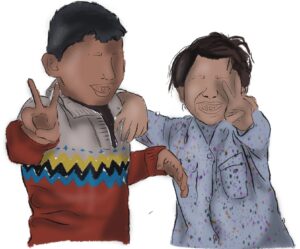
“Is it that kind which transforms into determination, and then, motivation, and then, resistance, and then, the Great Return March, and then Freedom. Is it?”
Abdalrahim Mohammed Alfarra, Youth Under Occupation The Palestine Project
Day 2 –Oh rascal children of Gaza
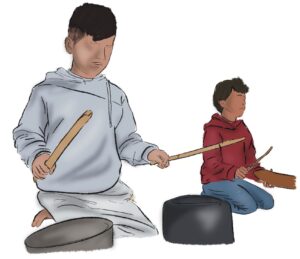
You who constantly disturbed me with your screams under my window,
You who filled every morning with rush and chaos,
You who broke my vase and stole the lonely flower on my balcony,
Come back —
And scream as you want,
And break all the vases,
Steal all the flowers,
Come back,
Just come back …
Khaled Juma, poet from Rafah, Gaza wrote this poignant tribute to the now over 500 children of Gaza killed by Israeli bombing.
Day 3 – Great March of Return
For what seems like weeks on end, the young men gather every Friday morning, in groups in different neighbourhoods, and chat with one another. “Good morning.” “How do you do?” It appears almost as casual as their demeanours suggest. However, after a while, they head east to join the border protests.
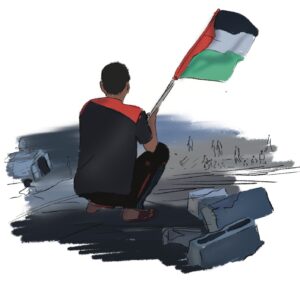
Politicians and local leaders take turns at the mic, some expressing anger at the occupation, others applauding the Palestinian resistance and cheering the cause. Some thundered into the mic of tearing down the fence and marching into, and reclaiming, their homeland. Many protesting share the sentiment but nobody is fool enough to believe it. Everyone knows what the march is – it’s a movement of united solidarity, every protestor with the other; a cry that had long been bubbling in the chests of every citizen was finally being let out. It was all they could do to keep from withering away inside completely or being blown up into smithereens.
The May sun is merciless and the protestors march, chant, and dance without respite. They have nothing to lose and a lot to say. Children hold up signs and flags, LIFT THE SIEGE reads the sign on one child’s keffiyeh wrapped around his head. Those injured from the previous week have shown up too; one man had come hopping on makeshift crutches, his bad foot swinging from the metal stick, and a group of girls walk slowly, aching from the torn skin on their knees from their fall running away from tear gas.
It’s not long before the tear gas canisters start dropping. There are sudden, loud bursts and the people drop in anticipation. White smoke lines against the bright blue sky before dropping to ground. Clouds of smoke start to take shape amongst the protestors and they begin to run – eyes burning, eyes closed – and keep running. Journalists in gas masks take photographs, leisurely almost, while the protestors run in all directions, gasping for air.
When the protestors walk back to their homes that night, they count themselves lucky. 60 people had died today, but they’d made it out alive. Some less alive than others – some had lost their parents, some their children, spouses, siblings, neighbours, cousins, coworkers, classmates and the list goes on.
The following days see 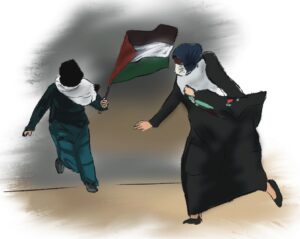
Atef Abu Saif, In Gaza, May Is the Cruelest Month
Rawan Yaghi, Gaza Screams for Life
The Palestinian Information Center (PIC), Palestinian Medic Witnesses Her Husband’s Death
teleSUR, Thousands of Palestinians Mark 1st Anniversary of Great March of Return
The West Bank
An estimated 2.7 million Palestinians live in the West Bank, 46% of whom are under the age of thirty. Over the past fifty years, 230 illegal Israeli settlements have been built in the West Bank, housing more than 400,000 Israelis(7). Settlements are made by forced evicitons of Palestinian homeowners. The demolition of homes, schools, livelihoods and other methods of coercion such as restrictions on farming and grazing land, and revocation of residency rights(8) force Palestinians to leave their communities.
Illegal settlements have a marked presence in the creation of barriers, checkpoints, fences, and buffer zones which are dotted all across the West Bank and severely restrict the movement and commerce of Palestinians. Skirmishes that occur between both populations are treated differently. When Palestinians are accused, 95% of cases are prosecuted with the application of Israeli military law. For Israeli suspects, only 9% of offenders are prosecuted and Israeli civil law applies(9).
The lives of Palestinians in the West Bank is marked by an acute shortage of water. Israeli settlers in the West Bank have long since seized dozens of Palestinain privately owned wells with the assistance of the Israeli military(10). Today, Palestinians in the West Bank survive using barely 20 litres of water per capita a day – that’s the minimum amount recommended by the WHO for emergency situations response. In contrast, Israeli settlers in the neighbouring regions use up to 20 times more water per capita(11).
Among the numerous Israeli atrocities in the West Bank are the destruction of essential water, sanitation, and hygiene infrastructure leading to displacement, increased poverty, and increased risk of disease and illness(12); the use of the West Bank as a “sacrifice” zone for building waste treatment plants for things such as sewage sludge, infectious medical waste, used oils, solvents, metals, electronic waste and batteries under lax rules(13); the placement of a virtual ban on issuing Palestinians permits for quarries and exploitation of natural resources in the region while being liberal with their Israeli and European counterparts(14); and enforced disappearance of cultural property such as the Palestine Archaeological Museum and its library in Jerusalem in 1967(15).
Day 4 – It’s My Home
February 2019
I have lived in this house for over 50 years. My family inherited this house generation after generation. My great grandmother planted the olive tree outside the house, my grandmother made the pillows in the guest room, and my mom embroidered the covers of the coffee table.
Then one day, the soldiers came and forced us all out of our home. My husband and my son tried to fight back but there were too many soldiers. They took them away, just like they took away my house.
Our neighbors shouted “Allahu Akbar!” and screamed at the soldiers, pleading with them that it was our home. But no one could change anything.
Time stopped as I stood there frozen, watching in horror as the settlers entered my house while I was thrown out. Everything inside was the same: my mother’s covers, our furniture, and even our clothes! They kept it all inside. Only we were thrown out.
The Israeli settlers went in and closed the door. I stood there outside in the street with my sisters and my neighbors, screaming and shouting at them. And all that came out of my mouth was
“It’s my home!”
“It is my home!”
Leena Mustafa, The Diaries of Palestine
Day 5 – Life in The West Bank
The day starts very early in Hebron, Occupied West Bank. Men wake up before the crack on dawn at 3 a.m. and head out twenty-one kilometers to Bethlehem for work. At 4:30 a.m., they arrive at Checkpoint 300 and join a long que to enter Bethlehem. They hope the soldiers don’t slack or pick on them; if the que stalls, they will miss their rides and will have to pay for a taxi.
The children wake early too. At 7 a.m. they start their kilometer long walk to get to school. They hope their escort won’t be late; if they walk alone, they become targets of Israeli settlers along the way. It’s usually soldiers in vehicles that follow them to keep attackers at bay, but sometimes Israeli activists and foreigners volunteer to walk them too. Going alone is dangerous.
Around noon, Eisa Amre, a coordinator of ‘Youth Against Settlements’, is giving foreign visitors a tour of Hebron. His tour group follows him through a checkpoint when an Israeli soldier disrupts their passage and takes away Eisa’s ID without explanation. The tourists stare bewildered in confusion, not understanding why they’ve been stopped. The soldiers do not explain themselves and demand they go back. After twenty minutes of back and forth, the soldiers turn away the cameras, return Eisa’s ID and let them proceed. They offer no explanation for their actions. Eisa turns to his group and tells them he was lucky they were with him. Had they not been with him, there was no telling how long he would’ve been detained by the soldiers. Hebron has twenty checkpoints. Palestinians must cross them to get to school, university, work, markets, other cities. They must cross them to get anywhere outside their immediate locality. Several times a day, Palestinians are held back at checkpoints and can be held there for hours on end without explanation.
Movement restriction is not imposed in the form of checkpoints alone. There is also the Aparthied Wall, formally known as the ‘Israeli West Bank barrier’. The 700 km wall started construction in 2002. The strangest thing about the wall is that it is not restricted to following around Israel’s border. Instead of surrounding the Green line, which is the de facto internationally recognized border based on the Armistice Line of 1949 and would’ve made some sense, it cuts straight into Palestinian territory. The Wall is complemented by a complicated system of ‘apartheid roads’ in the West Bank that has systematically destroyed the Palestinian road network and imposed a different road network for Israelis that Palestinians are not allowed to access. This means that streets that were once free to roam are now closed off for use by Palestinians. Shuhada street, for example, which was the central street of Hebron, bursting with markets, can now only be used by Israelis and foreigners – not Palestinians(16).
As Eisa shows his group around Hebron, the tourists take the Shuhada street while Eisa and the Palestinian cameramen with him use an alternative route, walking through a graveyard.
Peter Beaumont, A day in the life of the West Bank occupation
François Alfonsi, Jill Evans and Ana Miranda (Greens EFA), Living under occupation: Daily Life in Occupied Palestine
The Muslim Couch Potato
While the world knows a thing or two of the plight of Palestine, very few understand or care to learn about the reality on the ground. It isn’t just the story of another “oppressed minority”. Palestine is a land under occupation whose borders are being chipped away little by little everyday and Palestinian homes are literally being taken over(17).
The desperate videos, messages and writings that scatter the internet from the muffled voices of the Palestinians become subject to debate from unsympathetic people on the internet. They hide behind aliases, unafraid to belie and uncaring for the truth: a child being handcuffed and blindfolded by the Israeli military is called ‘fake news’, and a young man being shot dead for the crime of fishing a meter beyond a nonexistent boundary line is deemed to have ‘deserved it’.
When the Palestinian cry for help is being reduced to a few posts on a social media timeline and little beyond, it shows that something is seriously wrong with the bystanders. Palestine is locked away from the world and the indifference of the rest of the world enables Israel to get away with anything and everything. Who will step in when another innocent child is dragged away(18, 19)? Who will give the grandmother back her stolen house? Who can mend the crooked nose that once broke when a boy’s face was smashed into the ground during an air raid(20)?
If there is a solution, it will start when the Muslim Couch Potato is addressed. As John Esposito put it: “The Muslim Couch Potato is the person who gets up to put on their running outfit – only they don’t run, instead they sit down on their couch and watch football. The person who shows up at fundraisers but can’t reach for their wallet. The person who is always there when Palestine is being talked about, comments on the situation, cries about it, sweats for it but then when dinner rolls around, forgets about it. They drive back home and think they’ve made progress and have done what they needed to do.”
But the fact of the matter is that pretending to care doesn’t equal actual care and concern. The reality is that without the support of one’s community, a cause doesn’t make progress. Looking at past examples such as Italian Americans, Jewsish Americans, South East Asian Americans – people who were able to have an impact on their collective situation because they had the united support of their communities. Because when one is able to unite their community, they are able to pull in support from people outside the community. And unless the example is set in the community, alternative narratives of the cause will always dominate in terms of legitimacy. Unite your community. Take control of your narrative. People will listen. Things can change.
References
- Sabah, M. (n.d.). B’Tselem – The Israeli Information Center for Human Rights in the Occupied Territories. Over 90% of water in Gaza Strip unfit for drinking | B’Tselem. Retrieved March 2021, from http://www.btselem.org/gaza_strip/20140209_gaza_water_crisis
- Report of the independent international commission of inquiry on the protests in the Occupied Palestinian Territory, Human Rights Council 25 February 2019 p.6.
- Cumming-Bruce, Nick (18 March 2019). “U.N. Panel Urges Investigation Into Israeli Shootings at Gaza Border a Year Ago”. The New York Times. Retrieved 13 April 2019.
- (2020, April ). United Nations. Two Years On: People Injured and Traumatized During the “Great March of Return” are Still Struggling. Retrieved March 2021, from https://www.un.org/unispal/document/two-years-on-people-injured-and-traumatized-during-the-great-march-of-return-are-still-struggling/
- (2011, October ). United Nations Organization. HUMANITARIAN SITUATION IN THE GAZA STRIP. Retrieved March 2021, from https://reliefweb.int/sites/reliefweb.int/files/resources/Full%20Report_294.pdf
- Youssef AlKrunz, https://www.instagram.com/p/Bheq4w6FeUf/
- https://peacenow.org.il/en/settlements-watch/settlements-data/population
- (2020, January ). United Nations Office for the Coordination of Humanitarian Affairs. HUMANITARIAN RESPONSE PLAN OPT. Retrieved March 2021, from https://www.who.int/health-cluster/countries/occupied-palestinian-territory/Occupied-Palestinian-Territory-Humanitarian-Response-Plan-2020.pdf?ua=1
- https://www.bloomberg.com/quicktake/israeli-settlements
- Gideon Levy; Alex Levac (30 August 2019). “‘This Place Is Only for Jews’: The West Bank’s Apartheid Springs”. Haaretz. Archived from the original on 30 August 2019
- Thirsting for Justice – Palestinian Access to Water Restricted (PDF) (Report). Amnesty International. p. 2. Archived from the original (PDF) on 6 July 2016. Retrieved 15 March 2017.
- (2020, January ). United Nations Office for the Coordination of Humanitarian Affairs. HUMANITARIAN RESPONSE PLAN OPT. Retrieved March 2021, from https://www.who.int/health-cluster/countries/occupied-palestinian-territory/Occupied-Palestinian-Territory-Humanitarian-Response-Plan-2020.pdf?ua=1
- Aloni, Adam (December 2017). Made in Israel: Exploiting Palestinian Land for Treatment of Israeli Waste (PDF). B’Tselem. ISBN 978-965-7613-31-3.
- Niksic, Orhan; Eddin, Nur Nasser; Cali, Massimiliano (2014). Area C and the Future of the Palestinian Economy. World Bank Publications. ISBN 978-1-4648-0196-9.
- Glock, Albert (Spring 1994). “Archaeology as Cultural Survival: The Future of the Palestinian Past”. Journal of Palestine Studies. 23 (3): 70–84. doi:10.2307/2537961. JSTOR 2537961.
- STOP THE WALL – PALESTINIAN GRASSROOTS ANTI-APARTHEID WALL CAMPAIGN https://stopthewall.org/the-wall/
- Slemrod, A. (2020, October ). UN News. ‘High time for accountability’, UN expert says as Israel approves highest rate of illegal settlements . Retrieved March 2021, from https://news.un.org/en/story/2020/10/1076572
- Quds News Network, Israeli occupation detains 7 Palestinians, assaulted entire family https://qudsnen.co/?p=22910
- (July 2018) Holmes and Taha, The Guardian Ahed Tamimi: ‘I am a freedom fighter. I will not be the victim’ https://www.theguardian.com/world/2018/jul/30/ahed-tamimi-i-am-a-freedom-fighter-i-will-not-be-the-victim-palestinian-israel
- (2014) Beaumont, P. The Guardian, Israel pounds Gaza with air and naval strikes in move against Hamas https://www.theguardian.com/world/2014/jul/08/israel-pounds-gaza-against-hamas
With special thanks to:
Yara Younes, Life in Gaza: The world’s largest open air prison | The Palestine Project
Abdalrahim Mohammed Alfarra, Youth Under Occupation The Palestine Project
Leena Mustafa, The Diaries of Palestine
Copyright © 2021 Sumayya FS, unless otherwise mentioned (writing) & Zahra F. (art).
About the Author
Sumayya is a university student who dislikes talking about herself in third person.
Links: Twitter

